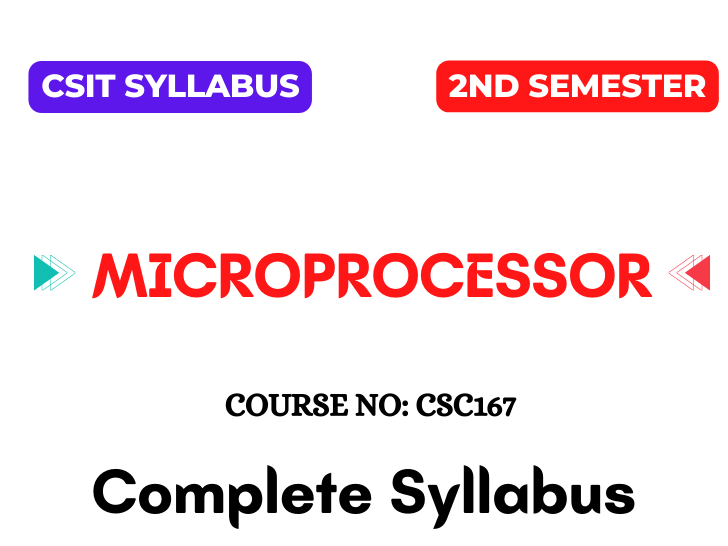Microprocessor Syllabus
General Information
| Course | B.SC. CSIT |
|---|---|
| Course Title | Microprocessor |
| Course No | CSC167 |
| Nature of the course | Theory + Lab |
| Semester | II (Second) |
| Full Marks | 60 + 20 + 20 |
| Pass Marks | 24 + 8 + 8 |
| Credit Hrs. | 3 |
CHAPTER LIST: Microprocessor
| S.N. | Chapter | Time |
|---|---|---|
| Unit 1 | Introduction | 4 Hrs |
| Unit 2 | Basic Architecture | 7 Hrs |
| Unit 3 | Instruction Cycle | 3 Hrs |
| Unit 4 | Assembly Language Programming | 10 Hrs |
| Unit 5 | Basic I/O, Memory R/W and Interrupt Operations | 6 Hrs |
| Unit 6 | Input/ Output Interfaces | 6 Hrs |
| Unit 7 | Advanced Microprocessors | 9 Hrs |
Course Description: This course contains of fundamental concepts of computer organization, basic I/O interfaces and Interrupts operations.
Course Objectives: The course objective is to introduce the operation, programming and application of microprocessor.
Course Contents:
Unit1: Introduction
(4 Hrs.)
Introduction to Microprocessor, Components of a Microprocessor: Registers, ALU and control & timing, System bus (data, address and control bus), Microprocessor systems with bus organization
Unit 2: Basic Architecture
(7 Hrs.)
Microprocessor Architecture and Operations, Memory, I/O devices, Memory and I/O operations, 8085 Microprocessor Architecture, Address, Data And Control Buses, 8085 Pin Functions, Demultiplexing of Buses, Generation Of Control Signals
Unit 3: Instruction Cycle
(3 Hrs.)
Fetch Operation and Timing Diagram; Execute Operation and Timing Diagram, Instruction Cycle, Machine Cycle, T-States, T-States, Memory Interfacing
Unit 4: Assembly Language Programming
(10 Hrs.)
Assembly instruction format, Instruction Types, Mnemonics, Operands, Macro assemblers, Linking, Assembler directives, Addressing Modes, Simple sequence programs, Flags, Branch, Jumps, While-Do, Repeat-Until, If-Then-Else and Multiple If-then Programs, Debugging
Unit 5: Basic I/O, Memory R/W and Interrupt Operations
(6 Hrs.)
Memory Read, Memory Write, I/O Read, I/O Write, Direct Memory Access, Interrupt, Types, Interrupt Masking
Unit 6: Input/ Output Interfaces
(6 Hrs.)
Interfacing Concepts, Ports, Interfacing Of I/O Devices, Interrupts In 8085, Programmable Interrupt Controller 8259A, Programmable Peripheral Interface 8255A
Unit 7: Advanced Microprocessors
(9 Hrs.)
8086: logical block diagram and segments, 80286: Architecture, Registers, (Real/Protected mode), Privilege levels, descriptor cache, Memory access in GDT and LDT, multitasking, addressing modes, flag register 80386: Architecture, Register organization, Memory access in protected mode, Paging
Laboratory Works:
The laboratory work includes Assembly language programming using 8085/8086/8088 trainer kit. The programming should include: Arithmetic operation, base conversion, conditional branching etc. The lab work list may include following concepts:
1. Assembly language program using 8085 microprocessor kit.
2. Use of all types of instructions and addressing modes.
3. Arrays and the concept of Multiplications and Division operations on Microprocessor.
4. Assembly language programming, using any types of Assembler, including the different functions of Int 10h, and 12h
Microprocessor Books
Text Books:
1. Ramesh S.Gaonkar, Microprocessor Architecture, Programming, and Applications with 8085, Prentice Hall
Reference Books:
1. A.P.Malvino and J.A.Brown, Digital Computer Electronics, 3rd Edition, Tata McGraw Hill D.V.Hall, Microprocessors and Interfacingv – Programming and Hardware, McGraw Hill
2. 8000 to 8085 Introduction to 8085 Microprocessor for Engineers and Scientists, A.K.Gosh, Prentice Hall


![NEB Class 12 Exam Routine 2082 [2025] 2 NEB Class 12 Exam Routine 2081/2082 [2025]](https://iswori.com.np/wp-content/uploads/2025/02/neb-class-12-routine.png)